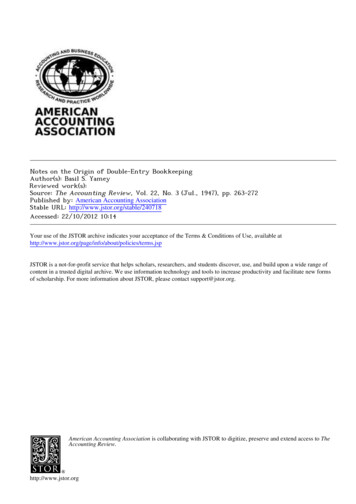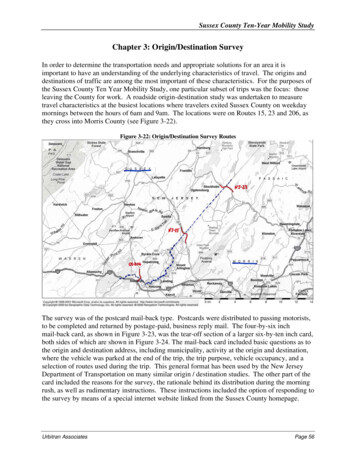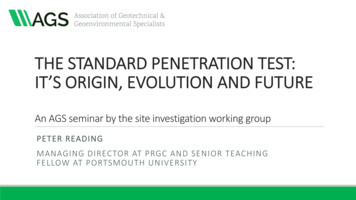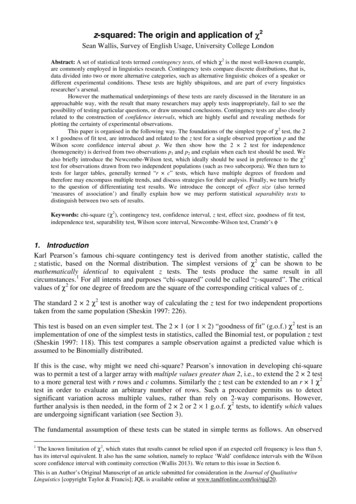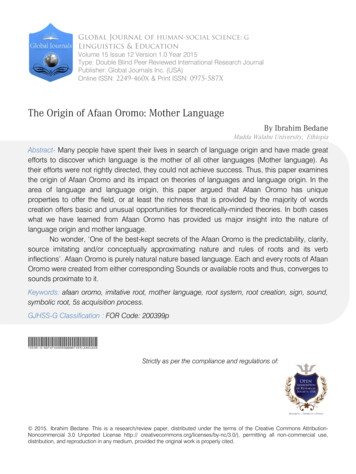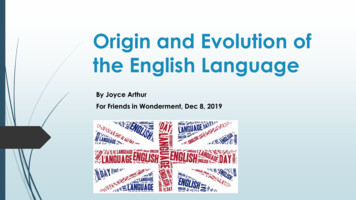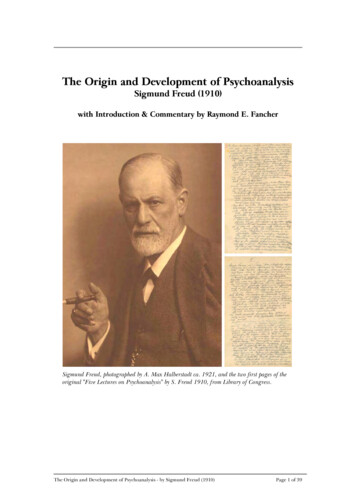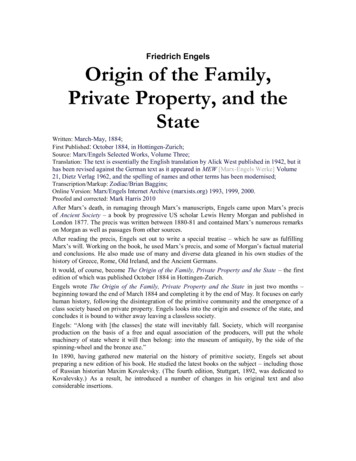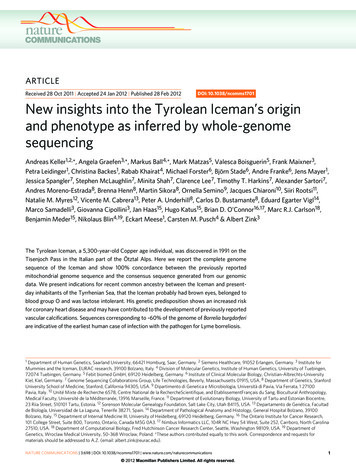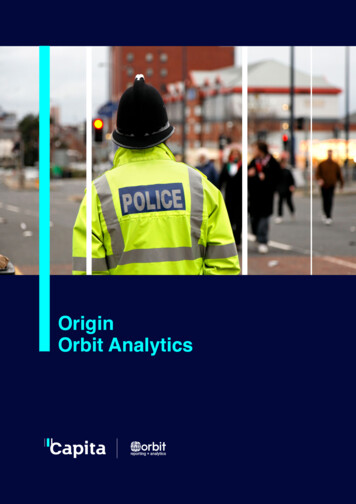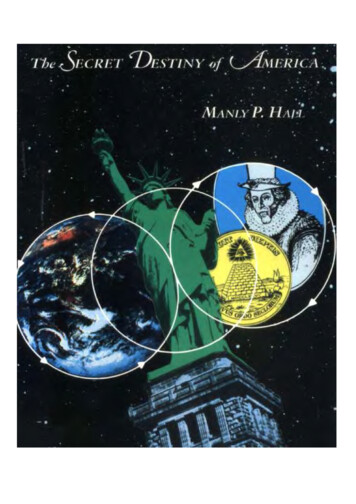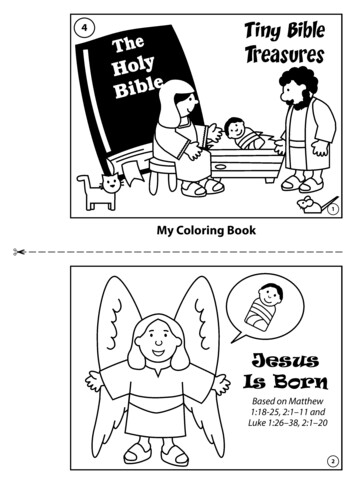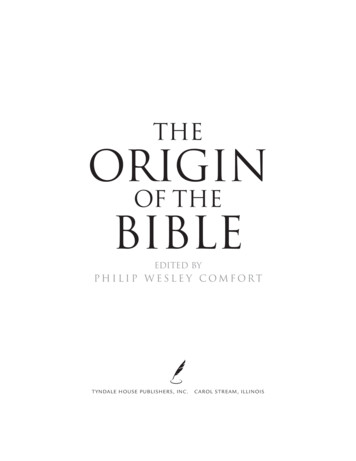
Transcription
THEORIGINOF THEBIBLEEDITed BYPh i l i p w e s l e y com f ortT YNDALE HOUSE PUBLISHERS, INC.Origin.indd iiiC AROL S TREAM, ILLINOIS8/3/2009 8:51:08 AM
Visit Tyndale’s exciting Web site at www.tyndale.comTYNDALEE and Tyndale’s quill logo are registered trademarks of Tyndale House Publishers, Inc.The Origin of the BibleCopyright 1992, 2003 by Tyndale House Publishers, Inc. All rights reservedDesigned by Lucas DaabScripture quotations marked NIV are taken from the Holy Bible, New International Version . NIV .Copyright 1973, 1978, 1984 by International Bible Society. Used by permission of Zondervan.All rights reserved.Scripture quotations marked KJV are taken from the Holy Bible, King James Version.Scripture quotations marked RV are from the Holy Bible, English Revised Version, 1881.Scripture quotations marked RSV are taken from the Holy Bible, Revised Standard Version, copyright 1946, 1952, 1971 by the Division of Christian Education of the National Council of the Churchesin the United States of America, and are used by permission. All rights reserved.Scripture quotations marked NRSV are taken from the Holy Bible, New Revised Standard Version,copyright 1989 by Division of Christian Education of the National Council of the Churches ofChrist in the United States of America, and are used by permission. All rights reserved.Scripture quotations marked NASB are taken from the New American Standard Bible, 1960, 1962,1963, 1968, 1971, 1972, 1973, 1975, 1977 by The Lockman Foundation. Used by permission.Scripture quotations marked TLB are taken from The Living Bible, copyright 1971. Used bypermission of Tyndale House Publishers, Inc., Carol Stream, Illinois 60188. All rights reserved.Scripture quotations marked NLT are taken from the Holy Bible, New Living Translation, copyright 1996. Used by permission of Tyndale House Publishers, Inc., Carol Stream, Illinois 60188. Allrights reserved.Permission granted by InterVarsity Press, England, to reproduce three articles from the New BibleDictionaryy (editor, J. D. Douglas), revised edition, 1982: “Bible” by F. F. Bruce, “Inspiration of theBible” by J. I. Packer, and “Canon of the Old Testament” by R. T. Beckwith.Permission granted by Philip Comfort to reproduce and adapt portions from The Complete Guide toBible Versions, published by Tyndale House Publishers, Inc., 1991.Permission granted by Baker Book House to reproduce and adapt portions of The Quest for the OriginalText of the New Testamentt by Philip W. Comfort, 1992.Library of Congress Cataloging-in-Publication DataThe origin of the Bible / editor, Philip Wesley Comfort.p. cm.Originally published: c1992.Includes bibliographical references.ISBN 978-0-8423-8367-7 (pbk.)1. Bible—Introductions. I. Comfort, Philip Wesley.BS475.3 .O75 2004220.1—dc222003018323Printed in the United States of America13 1298Origin.indd iv11710 09 0865 48/3/2009 8:51:08 AM
CONTRIBUTORSHarold O. J. Brown, Ph.D.former Professor of Biblical and Systematic TheologyThe Forman Professor of Ethics in TheologyTrinity Evangelical Divinity SchoolR. T. Beckwith, M.A.former Director, Latimer Trust, OxfordF. F. Bruce, M.A.former Rylands Professor of Biblical Criticism and ExegesisUniversity of Manchester, EnglandPhilip W. Comfort, Ph.D.Senior Editor, Bible Department, Tyndale House PublishersVisiting Professor, New Testament, Coastal Carolina UniversityRaymond L. Elliott, M.A. (Theology), M.A. (Linguistics)Member Emeritus of Wycliffe Bible Translators/Summer Institute ofLinguistics—translated the New Testament into Nebaj IxilMilton C. Fisher, Th.M., Ph.D., D.D.former Professor of Old TestamentReformed Episcopal Theological SeminaryR. K. Harrison, Ph.D., D.D.former Professor, Wycliffe CollegeUniversity of TorontoCarl F. H. Henry, Th.D., Ph.D.former Visiting ProfessorTrinity Evangelical Divinity SchoolMark R. Norton, M.A.Editorial Director, Bible Department, Tyndale House PublishersJ. I. Packer, M.A., D.Phil., D.D.Professor of Systematic TheologyRegent CollegeOrigin.indd v8/3/2009 8:51:09 AM
Leland Ryken, Ph.D.Professor of EnglishWheaton CollegeLarry Walker, Ph.D.former Professor of Old Testament and Semitic LanguagesMid-America Baptist Theological SeminaryVictor Walter, M.A., Th.M.former Chairperson of Practical TheologyTrinity Evangelical Divinity Schoolformer Pastor, Cheyenne Evangelical Free ChurchOrigin.indd vi8/3/2009 8:51:09 AM
CONTENTSIntroduction.ixSECTION ONEThe Authority and Inspiration of the BibleThe BibleF. F. Bruce.3The Authority of the BibleCarl F. H. Henry.13The Inspiration of the BibleJ. I. Packer.29The Inerrancy and Infallibility of the BibleHarold O. J. Brown.37SECTION TWOThe Canon of the BibleThe Canon of the Old TestamentR. T. Beckwith.51The Canon of the New TestamentMilton Fisher.65Old Testament and New Testament ApocryphaR. K. Harrison.79SECTION THREEThe Bible as a Literary TextLiterature in Bible TimesMilton Fisher.97The Bible as LiteratureLeland Ryken.111Origin.indd vii8/3/2009 8:51:09 AM
SECTION FOURBible Texts and ManuscriptsTexts and Manuscripts of the Old TestamentMark R. Norton.155Texts and Manuscripts of the New TestamentPhilip W. Comfort.185SECTION FIVEBible TranslationBiblical LanguagesLarry Walker.217Bible TranslationRaymond L. Elliott.239History of the English BiblePhilip W. Comfort.273Versions of the BibleVictor Walter.311Origin.indd viii8/3/2009 8:51:09 AM
INTRODUCTIONTHE BIBLE. No other book has had so many books written aboutit—so why yet another one? Though there are many books thathelp readers understand the content of the Bible, few explainits origins. This volume provides an overview of how the Biblewas first inspired, canonized, read as sacred literature, copied inancient Hebrew and Greek manuscripts, and translated into thelanguages of the world.The first section, “The Authority and Inspiration of the Bible,”focuses on the Bible’s divine inspiration, lasting authority, andinfallibility. The second section, “The Canon of the Bible,” revealsthe processes that went into selecting the thirty-nine books of theOld Testament and the twenty-seven books of the New Testament to be part of canonized Scripture. This section also has anessay on the Old Testament and New Testament apocrypha. Thethird section, “The Bible as a Literary Text,” elucidates the literary background of the Bible and shows how the Bible is a literarymasterpiece. The fourth section, “Bible Texts and Manuscripts,”describes the ancient biblical manuscripts that have been discovered and used in forming editions of the Hebrew and Greek texts.The fifth section, “Bible Translation,” provides information aboutthe biblical languages (Hebrew, Aramaic, Greek) and Bible translation itself. Furthermore, this section gives a brief history of theEnglish Bible and of other versions in many languages.I hope this book will inspire fresh appreciation for our Bible andgreater understanding of the processes that went into making theBible the inspired text that it is.Philip W. ComfortOrigin.indd ix8/3/2009 8:51:09 AM
SECTIONONETHEAUTHORITYANDINSPIRATIONOF THEBIBLEOrigin.indd 18/3/2009 8:51:09 AM
THE BIBLEF. F. BruceThe word “Bible” is derived through Latin from theGreek word biblia (books), specifically the books that are acknowledged as canonical by the Christian church. The earliest Christianuse of ta biblia (the books) in this sense is said to be 2 Clement2:14 (c. A.D. 150): “the books and the apostles declare that thechurch . . . has existed from the beginning.” (Compare Dan. 9:2,“I, Daniel, understood from the Scriptures,” where the referenceis to the corpus of Old Testament prophetic writings.) Greek biblion (of which biblia is the plural) is a diminutive of biblos, whichin practice denotes any kind of written document, but originallyone written on papyrus.A term synonymous with “the Bible” is “the writings” or “theScriptures” (Greek hai graphai, ta grammata), frequently used inthe New Testament to denote the Old Testament documentsin whole or in part. For example, Matthew 21:42 says, “Haveyou never read in the Scriptures?” (en tais graphais). The parallelpassage, Mark 12:10, has the singular, referring to the particular text quoted, “Haven’t you read this Scripture?” (ten graphentauten). 2 Timothy 3:15 (RSV) speaks of “the sacred writings” (tahiera grammata), and the next verse says, “All Scripture is Godbreathed” (pasa(graphe theopneustos). In 2 Peter 3:16 “all” the lettersof Paul are included along with “the other Scriptures” (tas loipasOrigin.indd 38/3/2009 8:51:11 AM
4 THE ORIGIN OF THE BIBLEgraphas), by which the Old Testament writings and probably alsothe Gospels are meant.CONTENT AND AUTHORITYAmong Christians, for whom the Old Testament and New Testament together constitute the Bible, there is not complete agreement on their content. Some branches of the Syriac church donot include 2 Peter, 2 and 3 John, Jude, and Revelation in theNew Testament. The Roman and Greek communions include anumber of books in the Old Testament in addition to those thatmake up the Hebrew Bible; these additional books formed partof the Christian Septuagint.While they are included, along with one or two others, in thecomplete Protestant English Bible, the Church of England (likethe Lutheran Church) follows Jerome in holding that they maybe read “for example of life and instruction of manners; but yetdoth it not apply them to establish any doctrine” (Article VI).Other Reformed Churches give them no canonical status at all.The Ethiopic Bible includes 1 Enoch and the book of Jubilees.In the Roman, Greek, and other ancient communions the Bible,together with the living tradition of the church in some sense,constitutes the ultimate authority. In the churches of the Reformation, on the other hand, the Bible alone is the final court ofappeal in matters of doctrine and practice. Thus Article VI of theChurch of England affirms: “Holy Scripture containeth all thingsnecessary to salvation; so that whatsoever is not read therein, normay be proved thereby, is not to be required of any man, that itshould be believed as an article of the Faith, or be thought requisite or necessary to salvation.” To the same effect the WestminsterConfession of Faith (1.2) lists the 39 books of the Old Testamentand the 27 of the New Testament as “all . . . given by inspirationof God, to be the rule of faith and life.”Origin.indd 48/3/2009 8:51:11 AM
THE BIBLE 5THE TWO TESTAMENTSThe word “testament” in the designations “Old Testament” and“New Testament,” given to the two divisions of the Bible, goesback through Latin testamentum to Greek diatheke, which in mostof its occurrences in the Greek Bible means “covenant” rather than“testament.” In Jeremiah 31:31, a new covenant is foretold whichwill supersede that which God made with Israel in the wilderness(cf. Exod. 24:7ff). “By calling this covenant ‘new,’ he has made thefirst one obsolete” (Heb. 8:13). The New Testament writers see thefulfillment of the prophecy of the new covenant in the new orderinaugurated by the work of Christ; his own words of institution(1 Cor. 11:25) give the authority for this interpretation. The OldTestament books, then, are so called because of their close association with the history of the “old covenant;” the New Testamentbooks are so called because they are the foundation documentsof the “new covenant.” An approach to our common use of theterm “Old Testament” appears in 2 Corinthians 3:14, “when theold covenant is read,” although Paul probably means the law, thebasis of the old covenant, rather than the whole volume of HebrewScripture. The terms “Old Testament” and “New Testament” forthe two collections of books came into general Christian use inthe later part of the second century; Tertullian rendered diathekeinto Latin by instrumentum (a legal document) and also by testamentum; it was the latter word that survived, unfortunately, sincethe two parts of the Bible are not “testaments” in the ordinarysense of the term.The Old TestamentIn the Hebrew Bible the books are arranged in three divisions:the Law, the Prophets, and the Writings. The Law comprises thePentateuch, the five “books of Moses.” The Prophets fall into twosubdivisions: the “Former Prophets,” comprising Joshua, Judges,Origin.indd 58/3/2009 8:51:17 AM
6 THE ORIGIN OF THE BIBLESamuel, and Kings; and the “Latter Prophets,” comprising Isaiah,Jeremiah, Ezekiel, and “The Book of the Twelve Prophets.” TheWritings contain the rest of the books: first are Psalms, Proverbs,and Job; then the five “Scrolls,” namely Song of Songs, Ruth,Lamentations, Ecclesiastes, and Esther; and finally Daniel, EzraNehemiah, and Chronicles. The total is traditionally reckonedas twenty-four, but these twenty-four correspond exactly to ourcommon reckoning of thirty-nine, since in the latter reckoning theMinor Prophets are counted as twelve books, and Samuel, Kings,Chronicles, and Ezra-Nehemiah as two each. There were otherways of counting the same twenty-four books in antiquity; in one(attested by Josephus) the total was brought down to twenty-two;in another (known to Jerome) it was raised to twenty-seven.The origin of the arrangement of books in the Hebrew Biblecannot be traced; the threefold division is frequently believed tocorrespond to the three stages in which the books received canonical recognition, but there is no direct evidence for this.In the Septuagint the books are arranged according to similarity of subject matter. The Pentateuch is followed by the historicalbooks, these are followed by the books of poetry and wisdom, andthese by the prophets. It is this order which, in its essential features, is perpetuated (via the Vulgate) in most Christian editionsof the Bible. In some respects this order is truer to chronological sequence of the narrative contents than that of the HebrewBible; for example, Ruth appears immediately after Judges (sinceit records things that happened “in the days when the judgesruled”), and the work of the chron
The fifth section, “Bible Translation,” provides in formation about the biblical languages (He brew, Aramaic, Gree k) and Bible trans-lation itself. Furthermore, this section gives a brief history of the English Bible and of other versions in many languages. I ho pe this book will ins pire fresh a ppreciation for our Bible
